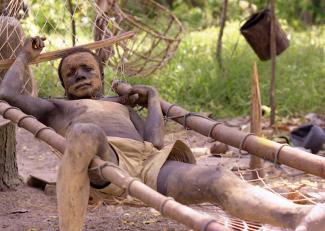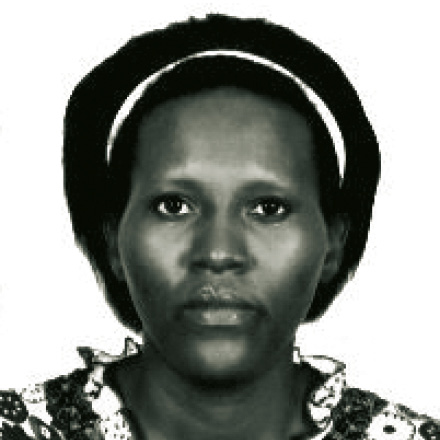Ecosystems
Not only wildlife depends on Andaman biodiversity
 Survival International
Survival International
As the name suggests, Little Andaman is one of the Andaman and Nicobar Islands. This remote belongs to India, though the Indian mainland is more than 900 km away from the northern most Andaman island. The distance to Myanmar is only about 200 km.
Tropical islands are typically hotspots of biodiversity (see Nicolas Zuël in the Focus section of D+C/E+Z e-Paper 2020/07). That is true of the Andaman and Nicobar Islands too. Forest officers have counted over 2500 species of flowering plants of which 223 species are endemic and not found anywhere else. An official note prepared last year also mentions 55 species of mammals (32 endemic), 244 species of birds (96 endemic) and 76 species of reptiles (24 endemic). With 179 species of corals, moreover, the islands have India’s richest coral reef. Many of these species are rare and endangered.
Historically, the archipelago was also marked by great cultural variety, with different indigenous peoples speaking different languages. Their cultures evolved over many centuries without contact to the outside world, but closely in touch with nature. Indeed, indigenous communities’ way of life is so interconnected to ecosystems that they are often considered to be guardians of the forest (see Carmen Josse in the Focus section of D+C/E+Z e-Paper 2019/02). Today, however, their descendants are called “particularly vulnerable tribal groups” (PVTGs) (see box).
The Onge
The Onge are a tiny community on Little Andaman. The census of 2011 counted 101 members. By law, a large part of the island belongs to this PVTG. The indigenous community is entitled to live there in harmony with the ecosystem that fits its age-old traditional way of life.
The Boxing Day Tsunami of 2004, which devasted the shores of the Indian Ocean, showed how well the Onge are adapted to their environment. The huge wage swept away their dwellings, and they were feared dead. However, every single Onge survived. Their traditional knowledge included that it is necessary to flee inland whenever the sea begins to withdraw from the coast. The Onge understood that it would soon hit back fiercely.
Nonetheless, the number of the Onge is so small that the survival of their culture is obviously at risk. Recent plans made in far-away New Delhi, India’s capital city, may put an end to it altogether. Quite likely, their implementation would even claim the individual lives of the remaining Onge.
The idea is to build two new mega-cities, one on Little Andaman and the other on Great Nicobar. Both would be free trade zones that, according to government officers, would grow to compete with global business hubs like Singapore, Hong Kong or Dubai.
The mega-cities proposal was made by NITI Aayog, an important government think tank. NITI stands for “National Institution for Transforming India”, and Aayog means “Commission” in Hindi. The planners, moreover, see scope for developing tourism. After all, the archipelago is close to internationally popular resorts in Thailand and Malaysia.
NITI Aayog promises both urbanisation schemes will be “sustainable”. However, it is neither obvious that large-scale business activity will take off at all, nor that it will prove lasting. Should it do so, however, serious environmental damage will be inevitable. In any case, the Onge will be exposed to considerable danger.
The vision of prosperous new megacities is fascinating (see Hans Dembowski’s blog post). Masses of Indians would indeed like to live in modern cities and enjoy the benefits of up-to-date infrastructure. However, the Andamans and Nicobars are very far away from the Indian mainland. The new free trade areas could thus not benefit from proximity to the huge Indian market. Hong Kong, by contrast, is part of China’s densely populated and highly industrialised Pearl River Delta, while Singapore serves as a financial centre for nearby Malaysia and Indonesia.
Today, only about 17,000 people live on Little Andaman. No doubt, the influx of many migrants from the Indian mainland would dramatically change the island’s ecology. They would not even have to count in the hundreds of thousands. Even if a new town arises instead of a megacity with millions of people, it would literally crowd out the tiny Onge community.
According to the plans, the new urban structures on Little Andaman would indeed occupy about 30 % of the territory that currently belongs to the tribe. Moreover, the Onge might easily succumb to diseases they are not immune to.
Sounding the alarm
Survival International, the London-based human-rights organisation, is sounding the alarm. It insists that no development should take place on Onge land without the indigenous people’s free, prior and informed consent. It is their legal right to assess all plans that affect their territory and have the final say.
Though the new urban agglomeration is officially being billed as “sustainable”, Sophie Grig of Survival International says: “There is nothing about it that looks very sustainable.” NITI Aayog’s proposals include an international airport, a casino strip, berthings for cruise ships, a theme park, hotels, golf courses and an opera house.
Worst of all, the official plans do not foresee the Onge’s free, prior and informed consent. According to the documents, currently protected tribal areas could simply be “de-notified”, so the tribal community would lose its rights. Indeed, the proposal bluntly states: “If required, the tribals can be relocated to other parts of island.”
Not all government officers are convinced that the urbanisation schemes are a good idea. Nilanjan Khatua, who is responsible for the Andamans and Nicobars at the Anthropological Survey of India, says that an impact assessment should be done before any plans are implemented.
By contrast, Vivek Rae, the central government’s former chief secretary for the Andaman and Nicobar Islands is enthusiastic about large-scale urban development plans. He speaks of “strategic advantages” and “considerable untapped economic potential”. In his eyes, India is guilty of having neglected the islands for a very long time.
The full truth, of course, is that the Andamans and Nicobars have not seen much development in the past because they are so very remote and because not many Indians wanted to move there. Moreover, there is a lot of seismic activity – in September 2021 alone two earthquakes were registered. The first had a magnitude of almost 4 on the Richter scale, the second exceeded the mark of 5.
To a large extent, the Andamans and Nicobars still remain a sanctuary of wildlife. While the ecosystems have survived so far, the indigenous peoples who depend on them have disappeared – or are likely to do so soon.
Link
Survival International webpage on the Onge
https://www.survivalinternational.org/tribes/onge
Anup Dutta is an Indian journalist.
Twitter: @duttanup

